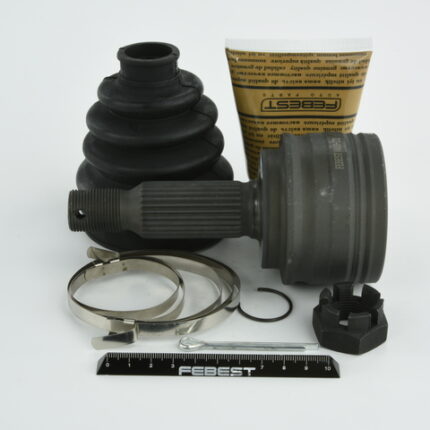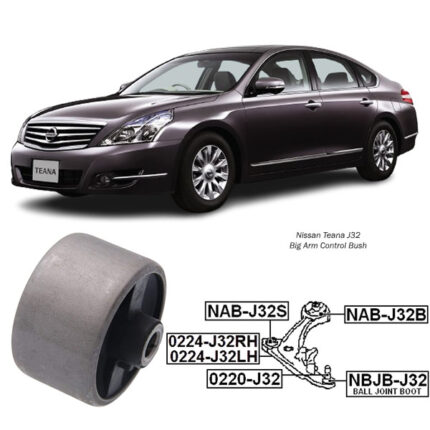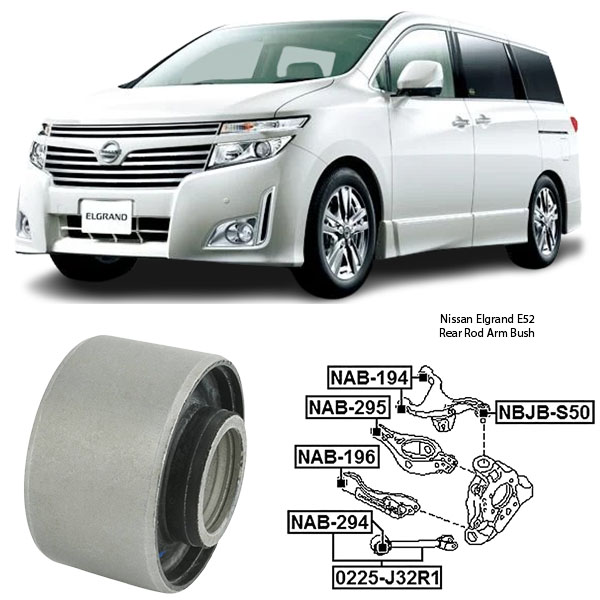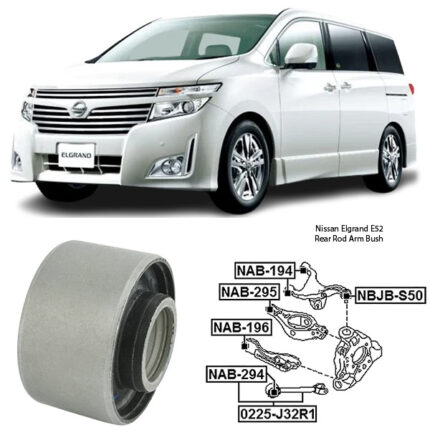Get Nissan Elgrand E52 Rear Rod Arm Bush NAB-294 in Kenya
The rear rod arm bush, also known as the rear control arm bushing or trailing arm bushing, is a crucial component in the rear suspension system of a vehicle. This bushing connects the rear control arm (or trailing arm) to the vehicle’s frame or axle, providing stability and control while allowing for the necessary movement of the suspension. Here’s a detailed overview of the rear rod arm bush, its functions, signs of wear or failure, and maintenance considerations:
Functions of Rear Rod Arm Bush
- Vibration Dampening
- Primary Function: Absorb and dampen vibrations and shocks from the road.
- Details: The rear rod arm bush is typically made of rubber or polyurethane, which helps to isolate the vehicle’s chassis from road vibrations and impacts, contributing to a smoother ride and reduced noise.
- Allowing Controlled Movement
- Primary Function: Facilitate controlled movement of the rear suspension components.
- Details: The bushing allows the rear control arm to pivot and move up and down with the suspension travel, maintaining proper alignment and stability of the rear wheels.
- Maintaining Suspension Geometry
- Primary Function: Ensure the correct alignment and geometry of the rear suspension system.
- Details: The rear rod arm bush keeps the suspension components in their correct positions, contributing to stable handling, consistent tire contact with the road, and overall vehicle stability.
Signs of Worn or Failing Rear Rod Arm Bush
- Clunking or Thumping Noises
- Description: Audible noises such as clunking, thumping, or knocking sounds from the rear suspension, especially when driving over bumps or uneven surfaces.
- Details: Worn rear rod arm bushes can develop excessive play, causing the control arm to move more than intended and create noise as it impacts other suspension components or the chassis.
- Increased Vibration
- Description: Noticeable increase in vibration or harshness felt through the vehicle’s cabin, particularly from the rear.
- Details: As the rear rod arm bushes wear out, their ability to absorb vibrations diminishes, leading to increased transmission of road vibrations to the vehicle’s body and a rougher ride.
- Poor Handling and Stability
- Description: Reduced handling performance, including increased body roll, rear-end instability, or wandering steering.
- Details: Worn rear rod arm bushes can alter the rear suspension geometry, leading to poor handling characteristics and compromised vehicle stability.
- Uneven Tire Wear
- Description: Abnormal or uneven wear on the rear tires, particularly on the inner or outer edges.
- Details: Failing rear rod arm bushes can cause misalignment of the rear suspension components, resulting in uneven tire contact with the road surface and premature tire wear.
- Steering Issues
- Description: Steering feels loose, vague, or less responsive, especially when navigating turns or driving at higher speeds.
- Details: Worn rear rod arm bushes can affect the alignment and movement of the rear suspension components, leading to steering issues and reduced response.
- Visible Damage or Wear
- Description: Visual inspection reveals cracks, tears, or deformation in the bushings.
- Details: Over time, rear rod arm bushes can degrade due to exposure to environmental factors such as heat, road salts, and contaminants. Visible damage indicates that the bushes may no longer be effective and need replacement.
Maintenance and Replacement
To ensure optimal performance and safety:
- Regular Inspection
- Check for Wear: Include rear rod arm bushes in routine maintenance checks, looking for signs of wear, damage, or deterioration.
- Detailed Examination: Inspect the bushings during vehicle servicing or when addressing any rear suspension-related issues.
- Prompt Replacement
- Replace When Worn: Replace any worn or damaged rear rod arm bushes promptly to prevent further damage to the rear suspension system.
- Quality Parts: Use high-quality OEM or reputable aftermarket bushings to ensure durability and proper fitment.
- Professional Installation
- Expert Service: Consider having a qualified mechanic perform the replacement, as it may require specialized tools and expertise to remove and install the bushings correctly.
- Alignment Check: After replacing the rear rod arm bushes, have a professional wheel alignment performed to ensure proper suspension geometry and handling.
Follow us on Facebook for more parts.




